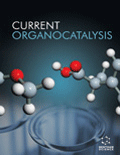- Home
- A-Z Publications
- Current Organocatalysis
- Previous Issues
- Volume 7, Issue 1, 2020
Current Organocatalysis - Volume 7, Issue 1, 2020
Volume 7, Issue 1, 2020
-
-
s Carbon Dots as Catalysts: A New Class of Nanozymes
More LessAuthors: Agatino Zammataro and Giuseppe T. SfrazzettoCarbon Dots (CDs) represent a new class of nanoparticles carbon-based having many application fields. This perspective summarizes the catalytic applications of CDs with potential future perspectives.
-
-
-
s Recent Contributions of Nuclear Magnetic Resonance in Organocatalysis Mechanism Elucidation
More LessBackground: Nuclear Magnetic Resonance (NMR) is one of the most employed techniques in structural elucidation of organic compounds. In addition to its use in structural characterization, it has been widely employed in the investigation of reaction mechanisms, especially those involving catalysis. Objective: In this review, we aim to provide recent examples of the interface of NMR and organocatalysis reaction mechanism. Read More
-
-
-
s High Catalytic Activity of Pd Nanoparticles Synthesized from Green Alga Chlorella vulgaris in Buchwald-hartwig Synthesis of N-Aryl Piperazines
More LessAuthors: Vaibhav Mishra, Anju Arya and Tejpal S. ChundawatBackground: The N-aryl piperazines are an important component of many drug products used for the treatment of malaria, depression, anxiety and Parkinson diseases. Buchwald-Hartwig amination is the latest and well-known reaction for Pd catalyzed direct synthesis of N-aryl piperazine from aryl halides. Although several Pd-ligand systems have already been discovered for this conversion, Pd nanoparticles are recently b Read More
-
-
-
s Adipic Acid as a Biodegradable Solid Acid Catalyst for One-Pot, Three Component Synthesis of 1-Amidoalkyl-2-naphthols
More LessAuthors: Hassan Darbandi and Hamzeh KiyaniBackground: 1-Amidoalkyl-2-naphthols are an attractive group of organic compounds that can be converted to oxazine heterocycles and aminoalkyl naphthols. The derivatives of 1- amidoalkyl-2-naphthols have significant biological activities and act as drug candidates. Methods: 1-Amidoalkyl-2-naphthols were synthesized via the three-component condensation reaction of 2-naphthol, acetamide/benzamide and various aldehydes Read More
-
-
-
s Synthesis of 7,3'-Epoxy-8,4'-Oxyneolignane-1’-Carboxylic Acid from Natural Eusiderin A and its Activity Against Trichophyton mentagrophytes
More LessBackground: Eusiderin A is a neolignan derivate, which makes up the majority of the secondary metabolite of Eusideroxylon zwageri. It has been reported as a potent biopesticide and antifungal agent. Previous studies on the oxidation of terminal methylene of the allylic chain in Eusiderin A have been able to produce primary alcohol, pinacol, and an aldehyde which demonstrated strong activity against plant pathogenic fungi Read More
-
-
-
s Novel Carbon-based Solid Acid from Green Pistachio Peel as an Efficient Catalyst for the Chemoselective Acylation, Acetalization and Thioacetalization of Aldehydes, Synthesis of Biscoumarins and Antimicrobial Evaluation
More LessAuthors: Fatemeh Ghorbani, Seied A. Pourmousavi and Hamzeh KiyaniBackground: Much attention has been focused on heterogeneous catalysts. Reactions with these recoverable and reusable catalysts are clean, selective with high efficiency. Among the heterogeneous solid acid catalyst in organic synthesis, Carbon-Based Solid Acids (CBSAs), which are important solid acid with many practical and research applications have been extensively studied. In this work, green Pistachio peel, a bi Read More
-
Most Read This Month
Article
content/journals/cocat
Journal
10
5
false
en

Most Cited Most Cited RSS feed
-
-
s Liquid Membranes in Catalysis
Authors: Muhammad W. Ashraf and M. Amin Mir
-
- More Less

